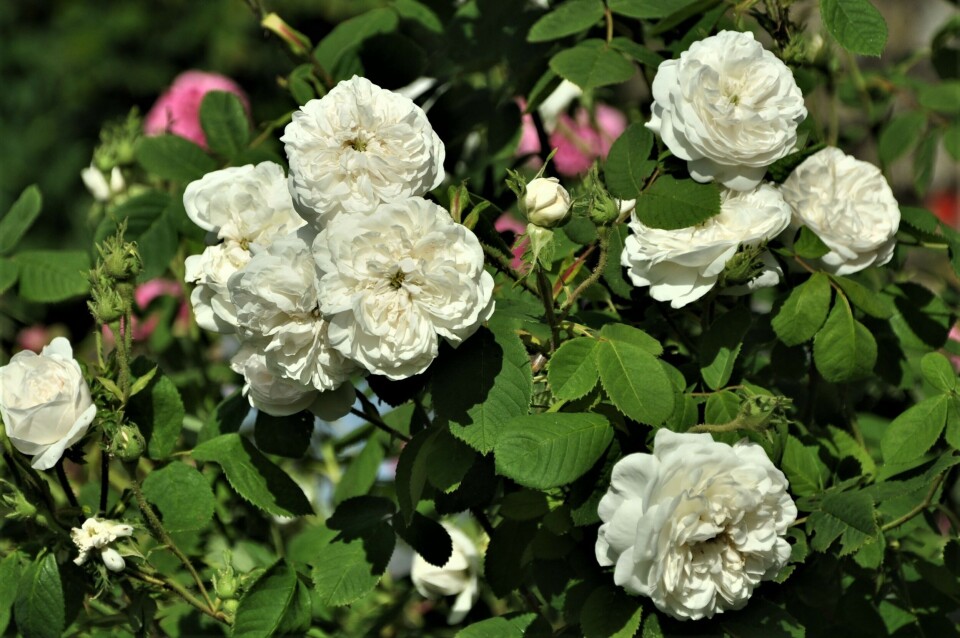-
Must you clear fallen leaves from your garden outside your home in France?
In most cases it is not legal to burn leaves once they have been raked up
-
My French garden: practicing patience with handkerchief trees
Find out how this flowering tree was discovered in China by a French priest
-
French gardening tips for November: bird feeders, potager tasks, and sustainable gifts
Seasonal advice to enhance your garden's beauty and productivity
French garden diary: New roses bred for resistance
We examine the floral options available to gardeners in France

As I have mentioned before, Brexit has gloriously removed my old safety blankets and forced me on horticultural journeys of discovery – and now there’s a new road ahead for the roses in my garden.
I have a grand total of 58 here, although at least three of these are on their way out, sad to say.
I have had severe problems with root dieback (on a heavy, winter-wet clay soil) and Blackspot susceptibility.
The old roses do magnificently.
It’s the more recent introductions that really suffer, such as the repeat-flowering Bourbons like ‘Mme Isaac Péreire’, a rose remarkable both for its beauty and vulnerability to Blackspot.
Although, in her defence, she does rally each spring for a marvellous show and is usually still flowering into December.
But the David Austins are even worse and all three of the previously mentioned malingerers – who I’m thinking of sending to the great compost heap in the sky – are from the Austin stable.
It was, therefore, with great interest that my recent gut feelings about the Austins were confirmed when I read an old 2010 article in The New York Times.
How I wish I had read it before beginning to plant my French garden!
‘More and better’
In the course of that article, Peter E. Kukielski – until 2014, curator of the Peggy Rockefeller Rose Garden at New York Botanic Garden, and widely recognised for his work in sustainable horticulture and disease resistance – suggests that our ancestors’ desire for ‘more and better’ has cost us dearly in rose health.
He says: “It was during that madness for the big fragrant bloom that never stopped, which began with the first hybrid perpetuals, back in the late 1800s, that the rose lost its disease resistance. The genetics started falling apart. The French were as mad about the hybrid perpetuals as the Dutch were about their tulips. But at the end of the season, these will have black spots, they will defoliate.”
These hybrid perpetuals are, with the Bourbons – enter ‘Mme Isaac Pereire’ stage left – the ancestors of many of our modern roses, the Austins included.
Compare their July foliage to the health of the older, once-flowering cultivars such as ‘Mme Hardy’, ‘Fantin Latour’ or the even older Albas.
Mr Kukielski is of the opinion that, “You will never know their [roses] true disease resistance until you stop spraying.”
Bringing me neatly to a famous French horticultural event, the Concours International de Roses at Orléans.
Award winning
In 2022, in the course of the 64th edition of this competition, the German company Kordes swept the board in more than one category, and the top ‘Médaille de la Ville’ was won by their cherry-red floribunda rose, ‘Enjoy’, which also took home the coveted prize for the environment, relating directly to disease resistance.
Kordes & Sons, based in Schleswig-Holstein, stopped spraying their rose fields against disease of any kind back in the 1990s and the roses they introduced after 2000 have proved exceptional for their disease resistance.
‘Enjoy’ had previously been awarded the German ADR label (Allgemeine Deutsche Rosenneuheitenprüfung, or General German Rose Novelty Test), which is only achieved after stringent, five-year field trials.
It’s an internationally respected scheme begun in the 1950s, primarily at the instigation of Wilhelm Kordes and other German rose growers, and you can bet your Kukielski dollar that these roses will be tough.
Those who adore modern, single to semi-double roses will find the Kordes catalogue a treasure-chest of joys (www.rosen.de/en).
Myself, I’m not too fond of a rose like ‘Enjoy’, leaning more to the soft colours of the old shrub roses, but even I can find a space in my heart (and my borders) for rich violet-red modern shrub rose ‘Ile de Fleurs’, which gained the ADR in 2018.
And there’s a wonderful guarantee: if it’s a shrub rose and Kordes are selling it, you can assume that it will not languish with Blackspot like my poor old ‘Mme Isaac Péreire’.
They even list and sell some of the older shrub roses that have coped well under their ‘no-spray’ field conditions.
Try ‘Jacques Cartier’ (1868), magenta-pink ‘Rose de Rescht’ (1840), or violet-pink ‘F. J. Grootendurst’ (1918) – all repeat flower to some extent.
Moving on from the Kordes stable, two of the latest in a range of roses that French parks’ departments have been experimenting with in municipal planting schemes were awarded the German ADR label in 2021: ‘Emera’ in fuchsia-red and ‘Opalia’ in pure white.
Originally bred in Germany, the Décorosier range of landscaping roses, to which ‘Emera’ and ‘Opalia’ belong (www.decorosiers.com), is now exclusively produced in France and boasts a colour palette of more than fifteen varieties.
Verdia, the company that produces them, believes that they are the “beginning of a garden revolution” offering roses that are both “easy and generous”.
If you are not hooked on the old rose style these easy-going beauties are a must for continuous garden flower on a plant that grows no more than about 80cm tall.
What’s your favourite rose or rose breeder, if you are thinking primarily of disease resistance? Contact Cathy at editor@connexionfrance.com.
Related articles
Salamanders and singing toads in France
Lovely Limousin gardens to visit in June with Open Gardens scheme
























